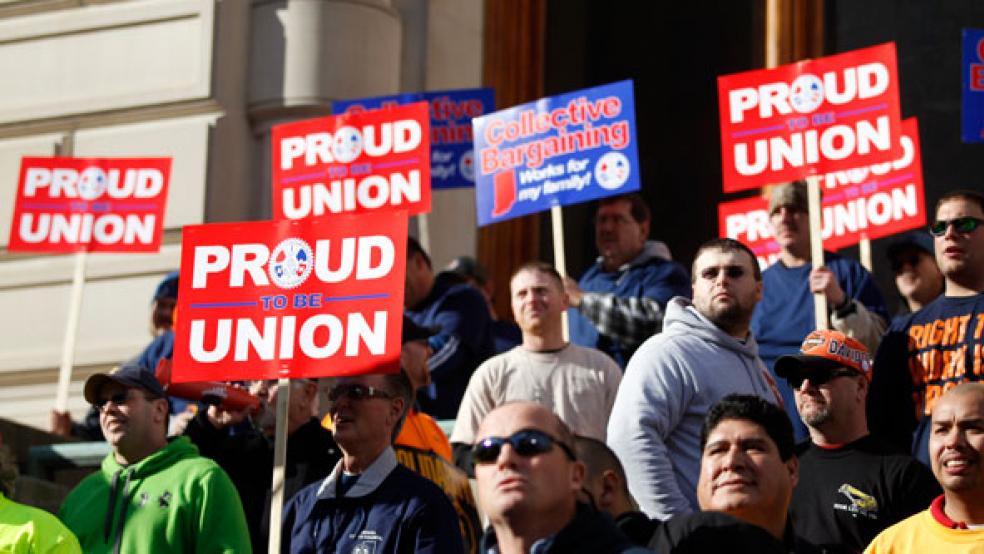As another Labor Day rolls around on Monday, a new Gallup survey of Americans’ attitudes about the labor movement shows that just 53 percent still approve of unions and their goals – while the vast majority favors so-called “right to work” laws that have greatly accelerated the decline of private-sector union organizations.
Labor unions once had enormous political and economic clout in this country, but their influence and support have waned in the private sector while growing more robustly in the government sector.
Related: Supreme Court Throws Wrench into Unions’ Organizing Effort
Indeed, public approval of the labor movement once was as high as 75 percent in the 1950s, when giants such as George Meany of the AFL-CIO and John L. Lewis of the United Mine Workers dominated the movement.
Today, nearly one in four Americans disapproves of organized labor, while 71 percent endorse the right-to-work laws, which are anathema to union members. Those laws – currently in force in 24 states – allow workers to hold jobs in unionized workplaces without joining a union.
After decades of declining membership, loss of jobs to overseas markets, internal union strife, and corruption, the labor movement today is struggling to hang on as the economy and industry undergo dramatic change.
Public sector unions, including AFSCME (the American Federation of State, County and Municipal Employees), the American Federation of Government Employees, and the American Federation of Teachers, enjoy a membership rate of 35.3 percent, according to Department of Labor statistics. That is five times greater than the 6.7 percent union rate within the private sector job market.
Related: Big Labor’s Mounting Feud with Barack Obama
“Hardly a day goes by when American unions are not attacked from some quarter,” Thomas A. Kochan, a professor of industrial relations and employment at the Massachusetts Institute of Technology’s Sloan School of Management, wrote recently in Fortune.
The assaults range from a Supreme Court decision that weakened unions representing home care workers, to a California judge’s ruling throwing out teacher tenure and seniority rules, to a few states like Wisconsin that have stripped public employees of collective bargaining rights.
“It’s clear that for years most private sector employers have successfully fought union organizing and collective bargaining, using every legal delaying tactic and in many cases illegally firing workers,” Kochan wrote. “Wal-Mart, the nation’s largest private employer, is the most visible case in point. By deploying its union-fighting swat team from corporate headquarters to any store that shows signs of worker protest, it has remained 100 percent ‘union-free.’”
Gallup says the popularity of right-to-work laws stems largely from the widespread conviction that no American should be required to join any private organization against his or her will.
Related: Obama’s Auto Bailout Was Really a Hefty Union Payoff
The new poll found that 82 percent of Americans agree with that. Some pro-union forces – mostly Democrats – partly oppose right-to-work laws because of the “free-rider” problem. That is, “non-union workers benefit as much as union workers when unions negotiate pay and benefit increases with employers,” according to the Gallup analysis.
Republicans disapprove of unions by 57 percent to 32 percent and support right-to-work laws by 74 percent to 18 percent, according to Gallup’s findings. Democrats overwhelmingly approve of labor unions, but they feel nearly as strongly as Republicans that workers should not be forced to join unions and pay dues if they don’t want to.
The AFL-CIO contends that “extremist groups, right-wing politicians and their corporate backers want to weaken the power of workers and their unions” through "right to work" laws.
“Their efforts are a partisan political ploy that undermines the basic rights of workers,” the AFL-CIO said in a statement. “By making unions weaker, these laws lower wages and living standards for all workers in the state. In fact, workers in states with these laws earn an average of $5,680 less a year than workers in other states. Because of the higher wages, working families in states without these laws also benefit from healthier tax bases that improve their quality of life.”
Top Reads from The Fiscal Times:





